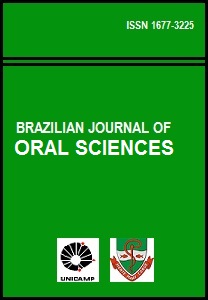Abstract
Understanding that dental caries has multifactorial aspects, we attempted to verify the influence of food habits, oral hygiene practices, and parents’ education level in the occurrence of this disease in children. One-hundred-thirty children, aged 0 to 60 months, both male and female, were examined in the municipality of Bilac- São Paulo- Brazil. The examination was carried out on the day of National Multivaccination Campaign, using the DMFT index, with the codes and criteria established by WHO. A questionnaire with open and closed questions about children’s food and hygiene habits and parents’/ tutors’ level of education was applied to parents/tutors. The data were processed using Epi-Info 6.04 software, having been considered significant at p<0.05. It was verified that 83% of the children were bottle fed at night. Of these, 79.6% had the contents of the bottle added with sugar, and this factor was associated with dental caries (p=0.01; OR=1.2; CI=0.2 – 2.3). Oral hygiene had been started before one year of age in 54.6% of the children, and it was carried out twice a day in 46.1% of the cases. Regarding the education level of parents, 51.5% of the mothers and 53.8% of the fathers had more than eight years of education. There was no relationship between the parents’ level of education and the presence of dental caries.References
Brasil. Ministério da Saúde. Secretaria nacional de Programas Especiais em Saúde. Divisão nacional de Saúde Bucal. Levantamento epidemiológico em Saúde Bucal: Brasil, Zona Urbana; 1986. CD-MS.
Marcenes W, Bönecker M J S. Aspectos epidemiológicos e sociais das doenças bucais. In: Buishi YP. Promoção de saúde bucal. São Paulo: Artes Médicas; 2000. p.73-98.
Nadanovsky P. O declínio da cárie. In: Pinto VG. Saúde bucal coletiva. São Paulo: Santos; 2000. p.341-51.
Fejerskov O. Conceito de cárie dental e suas conseqüências. Encarte científico ABOPREV 1998; 2: 1-4.
Fraiz FC, Walter LRF. Study of factors associated with dental caries in children who receive early dental care. Pesq Odontol Bras 2001; 15: 201-7.
Persson LA, Holm AR, Arvidson S, Samuelsson G. Infant feeding and dental caries – longitudinal study of Swedish Children. Swed Dent J 1985; 7: 201-6.
Rossow L, Kjaernes U, Holst D. Patterns of sugar consumption in early childhood. Community Dent Oral Epidemiol 1990; 18: 12-6.
Silver DH. A comparison of 3 years-old caries experience in 1973, 1981 and 1989 in a Herefordshire town, related to family behavior and social class. Br Dent J 1992; 172: 191-7.
Moynihan PJ, Holt RD. The national diet and nutrition survey of 1,5 to 4,5 year old children: summary of the findings of the dental survey. Br Dent J 1996; 181: 328-32.
Fraiz FC, Issao M. The first time of and sugar consumption by nursing bottle. J Dent Res 1995; 7: 785.
Maas AMN, Bavaresco EM, Missio SF, Spironello RT. Estudo comparativo de índice de cárie dentária e higiene oral entre escolares da rede pública e de rede privada. Rev Fac Odontol Pelotas 1993; 4: 23-8.
Narvai PC, Frazão P, Castellanos RA. Declínio na experiência de cárie em dentes permanentes de escolares brasileiros no final do século XX. Odonto Sociedade 1999; 1: 25-6.
WHO (World Health Organization). Oral health survey: basic methods. 4. ed. Geneva: WHO; 1997.
Freire MCM. Dieta, saúde bucal e saúde geral. In: Buischi YP. Promoção de saúde bucal na clínica odontológica. São Paulo: Artes Médicas; 2000. cap.10, p.249-78.
Matee MJN, Mikx FH, Maselle SY, Van Palenstein Helderman WH. Mutans streptococci and lactobacilli in breast-fed children with rampant caries. Caries Res 1992; 26: 183-7.
Melo Santos L, Forte FDS, Bosco VL, Rocha MJC. Aleitamento e Cárie dentária. Rev Fac Odontol Univ Fed Bahia 2000; 20: 34-7.
Ripa LW. Nursing caries: comprehensive review. Pediatr Dent 1988; 10: 268-82.
Alencar ACC, Lira MC, Carvalho VA, Rodrigues MJ. Relação entre o tipo de aleitamento e de higiene bucal e a presença de cárie de mamadeira em crianças de 6 a 58 meses de idade. Rev Fac Odontol Pernambuco 1997; 5: 31-6.
Ayhan H. Influencing factors of nursing caries. J Clin Pedatr Dent 1996; 20: 313-6.
Benitez C, O’Sullivan D, Tinanoff N. Effect of a preventive approach for treatment of nursing bottle caries. J Dent Child 1994; 61: 46-9.
Feldens EG, Feldens CA, Raupp SMM, Wessler ALM, Graeff SL, Kramer PF. Avaliação da utilização de dentifrício fluoretados por crianças de 2 a 5 anos de idade de 3 escolas da cidade de Porto Alegre. J Bras Odontopediatr Odontol Bebe 2001; 4: 375-82.
Benedetto MS, Zardetto CGDC, Bönecker MJS, Barreto MAC, Correia MSNP. Correlação epidemiológica de prevalência e necessidade de tratamento de cárie dentária entre mães e bebês de 6 a 24 meses de idade em são Paulo. J Bras Odontopediatr Odontol Bebe 1999; 2: 357-61.
Newbrun E. Current regulations and recommendations concerning water fluoridation, fluoride supplements and topical fluoride agents. J Dent Res 1992; 71: 1255-65.
Buzalaf MAR, Bastos JR, Lauris JRP, Almeida BS, Aquilante AG. Association between the early use of toothpaste and other variables with dental fluorosis: a transversal and retrospective study. Rev Fac Odontol Bauru 2002; 10: 196-200.
Villena RS, Cury JA. Flúor: uso racional. In: Corrêa MSNP. Odontopediatria na primeira infância. São Paulo: Santos; 1998. p.291-314.
Santos NB, Ferreira NF, Garbin CAS, Moimaz SAS, Saliba NA. Percepção e aplicação de medidas preventivas odontológicas - pacientes gestantes FOA/UNESP. Pesq Odontol Bras 2002; 16 (Supl): 184.
Garbosa CS, Walter LRF. Estudo da prevalência de cárie numa população de 0 a 5 anos atendidas precocemente pela Bebê Clínica da Universidade Estadual de Londrina. Semina 1997; 18(Ed Esp): 51-4.
Milanez F G, Walter LRF. Estudo comparativo entre a presença de placa visível e cárie dentária em crianças de 18 a 40 meses de 2 populações distintas. Semina 1997; 18(Ed Esp): 47-50.
The Brazilian Journal of Oral Sciences uses the Creative Commons license (CC), thus preserving the integrity of the articles in an open access environment.

